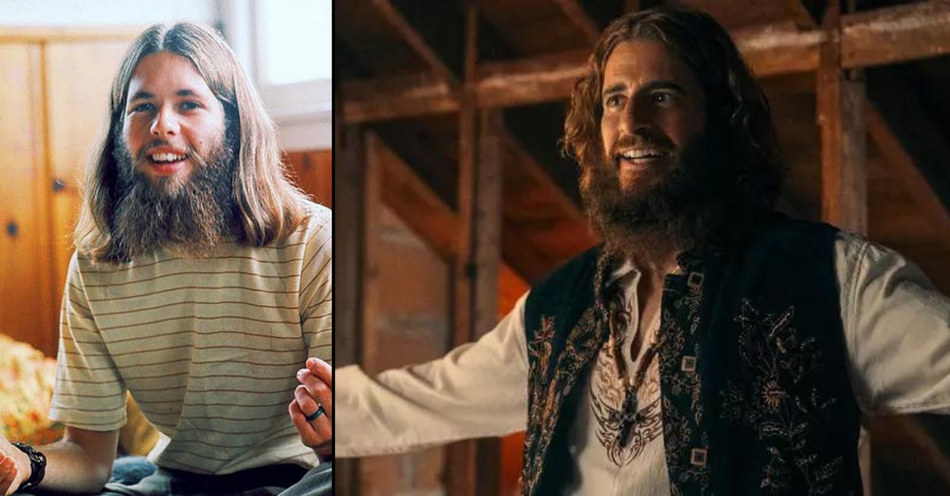Lonnie Frisbee is among the more surprising people mentioned in the movie Jesus Revolution. Some called him “the first Jesus freak” or the first Jesus hippie. He played a key role in Chuck Smith’s Calvary Chapel church becoming a massive association. He was “the young man” John Wimber mentions prompting a spiritual outpouring that kickstarted the Vineyard Movement.
So, why isn’t Frisbee remembered as well as Smith or other members of the Jesus Movement? Like many of the Jesus hippies, his spiritual journey and lifestyle choices were complex, making him a hard man to classify.
However, as we will see, his complexities did not keep God from using him.
Note: This article includes discussions about child abuse, and various controversial behavior connected to the hippie movement.
Important Events in Lonnie Frisbee’s Life
1. Lonnie Ray Frisbee was born June 6, 1949, in Santa Ana, California, to Ray Frisbee and Jeannette Ashley. He described his upbringing as unstable—his parents were in their mid-teens when they married, and his father was abusive.
2. In 1953, Ray Frisbee disappeared with a woman named Velma Graham. Frisbee’s mother attempted to locate Ray and met Velma’s husband, Lyle Graham. They married and had two sons. Frisbee described this period as unstable in different ways—his stepfather was distant, and a babysitter abused him at age eight. Around this time, Frisbee prayed and accepted Jesus as his savior while attending a church puppet show.
4. Frisbee’s family moved to Costa Mesa, California, and he attended Corona Del Mar High School. He became involved in the arts and, in 1966, appeared as a backup dancer on the music show Shebang hosted by Casey Kasem.
5. Dropping out of high school at 15, Frisbee moved to San Francisco’s Height-Ashbury neighborhood, pursuing studies at the Academy of Art School. During this period, he experimented with reading the Bible while also taking marijuana and LSD.
6. In 1967, Frisbee and several friends traveled to Tahquiz Canyon outside Palm Springs. Frisbee began reading the Gospel of John to his friends and later reported that while taking LSD, he had a vision where he preached to crowds crying for salvation.
7. Shortly after his vision experience, Frisbee met Ted and Elizabeth Wise, early evangelists to the San Francisco hippie population. For several months, Frisbee stayed in the Wises’ Christian commune, the Big House. During this period, he married Connie Bremer (later Connie Bremer-Murray).
8. In 1968, Frisbee met Chuck Smith, lead pastor of Calvary Chapel Costa Mesa. Smith was interested in ministering to hippies and offered Frisbee a place to stay. Frisbee began holding Wednesday night Bible studies and evangelizing to anyone he met. Historians consider Frisbee’s evangelism a key part of the Jesus Movement and of Calvary Chapel becoming a global church network.
9 In 1971, Frisbee parted ways from Calvary Chapel, partly over conflicts with Smith about the place of spiritual gifts in the ministry. Frisbee worked in various positions—Bob Mumford’s Shepherding Movement in Florida, missionary work on four continents—before returning to California in 1977. His marriage ended in 1973, though Bremer-Murray stated they became friends again in the last decade of his life.
10. In 1980, pastor John Wimber asked Frisbee to speak at his church, Calvary Chapel Yorba Linda. Frisbee’s message sparked a great response, followed by huge attendance growth and various “signs and wonders.” This momentum helped Wimber create the Association of Vineyard Churches, later known as the Vineyard Movement.
Frisbee contributed to several other ministries before he died on March 12, 1993, from AIDS complications. Chuck Smith gave a eulogy comparing Frisbee to Samson at his funeral in Crystal Cathedral.
What Can We Learn from Lonnie Frisbee?
1. God can use the people we least expect. Few would imagine that an 18-year-old who dropped out of high school would help a church grow from two hundred to several thousand members to several thousand… and do it again with another church over a decade later. God is in the business of using methods that surprise the wise.
2. Being childlike opens new doors. Frisbee’s brother Stan observed that one of his brother’s key traits was a childlike faith, which allowed God to accomplish great things through him.
3. God can redeem what has been lost. While Frisbee’s relationship with Smith became complicated, Stan Frisbee and others observe that Smith became his affirming father figure after several terrible ones.
4. Early success brings its own setbacks. Frisbee went from spiritual wanderer to trailblazing preacher-evangelist in less than three years. However, Bremer-Murray recalled that his busy schedule and the resulting ministry pressure created marital problems. Like many Christians who break new ground, his work changed lives but made it hard to live a balanced life.
5. Spiritual passion without spiritual development creates problems. Frisbee’s passion for sharing the gospel and for spiritual gifts is uncontested. It’s clear that many became saved through his ministry, and some surprising spiritual things happened along the way. However, he was still a teenager when he started his ministry, still learning many things. Bremer-Murray, Stan Frisbee, John Ruttkay, and others suggest he lacked the balanced mentoring he needed.
6. Our leaders are complicated. Until the early 2000s, many Christian leaders hesitated to discuss Frisbee because of his sexuality and death from AIDS. Bremer-Murray states he didn’t identify as a gay man, and his friend Mike Turriggiano said, “although he never hid from us the fact that he was a hurting pup this was a side of Lonnie we never saw.” Regardless of how he defined his sexuality, his life shows that leaders are never as simple as their followers want to believe.
7. Revolutionary times can breed darkness as well as light. John Ruttkay recalls that Frisbee experienced a crisis when he got involved in Bob Mumford’s Shepherding Movement, an example of how the Jesus Movement produced inspiring leaders and cultish ones.
8. The past is not as easy as we like to think. Even if we overlook questions about Frisbee’s sexuality, he belonged to a movement of surprising people. His fellow Jesus hippies often found Jesus after experimenting with various drugs and living situations. After becoming Christians, many still held countercultural views that wouldn’t fit today’s “evangelical” label. As we discuss the Jesus Movement, we must remember there is no clean-cut narrative that makes every contributor easy to accept.
9. Legacy may mean more than we think. In the first volume of his autobiography, Frisbee observes that while his family life was volatile, he discovered something surprising years later: his mother’s family had a long line of ministers, a line he unintentionally continued.
10. Blessings can come even after pain. In the final volume of his autobiography, Frisbee reports that while he went through a backsliding period in the early 1980s, 1989 onward brought “the most glorious season of anointing and healing of my entire life.”
What Others Have Said about Lonnie Frisbee
“I was not at all prepared for the love that this young man would radiate… His love of Jesus and his Spirit-filled personality lit up the room.” — Chuck Smith
“Lonnie was such a risk taker. He had this childlike quality about him that was almost a God-given thing. It wasn’t something he worked to acquire into his personality or anything. It was just the way he was.” — Connie Bremer-Murray
“Lonnie held Monday night meetings dedicated to the teaching and practicing of the Holy Spirit. Much of what I carry in my heart and what has made me effective over the past couple of decades in planting churches has come from those Monday night meetings at a Long Beach church.” — Steve Sjogren
“In all my past experience with ministry, the leaders had meetings, planned the events, and pretty much knew what was going to happen and when… Lonnie made no distinction between a meeting and the rest of life. Every moment of every day seemed to be set apart, an opportunity.” — Ken Gulliksen
“There are many chapters in Lonnie’s story, some bright as the morning light, and some as dark as midnight. He came from a horrifying background of brokenness and abuse, but was chosen by God to release Jesus’ ministry in tremendous wonder and power.” — Lou Engle
“I met people, and the love they radiate for Lonnie is quite amazing. Yes, he could be tough to deal with, he could be a good friend but a prickly character. He was real. He would love people to the point where he’d encourage them in faith to step out and do great things for God.” — Daniel DiSabatino
“It is time to recognize Lonnie Frisbee for who he was—a flawed man who passionately sought the will of God and shared that passion with seekers, a man who sinned and made mistakes but made such a difference in the lives of countless young people in an era when the youth of this country desperately needed a way back to God.” — Greg Laurie
Where to Learn More about Lonnie Frisbee
Here are some of the best resources about Frisbee.
1. The Jesus Revolution. This biopic depicts Frisbee’s collaboration with Smith and how their work became a foundational stone in the Jesus Movement.
2. Frisbee: The Life and Death of a Hippie Preacher. This 2005 documentary combines archival footage and interviews with Frisbee’s friends and family to detail his life and struggles.
3. The Jesus People Movement: An Annotated Bibliography and General Resource by Daniel DiSabatino. DiSabatino’s 2005 documentary on Frisbee grew from a larger project researching the Jesus Movement. This book presents the research, giving students a great resource on this fascinating period.
4. The Jesus People Movement: A Story of Spiritual Revolution Among the Hippies by Richard A. Bustraan. Bustraan concisely summarizes Frisbee and his contemporaries.
5. Not By Might Nor By Power: The Jesus Revolution. The first part of Robert Sach’s authorized ghostwritten account of Frisbee’s life covers his childhood through his ministry at Calvary Chapel.
6. Not By Might Nor By Power: The Great Commission. The second part starts in 1977 with Frisbee’s missionary period, followed by his association with John Wimber.
7. Not By Might Nor By Power: Set Free. Sach’s final book looks at Frisbee’s last decade, particularly a “dark season of the soul” between 1983 and 1989, where he struggled considerably with his faith.
8. No Sympathy for the Devil: Christian Pop Music and the Transformation of American Evangelicalism by David Ware Stowe. An in-depth look at how Christian rock evolved from the Jesus Movement and how Frisbee, the Wises, and other key figures created a countercultural Christianity.
9. God’s Forever Family: The Jesus People Movement in America by Larry Eskridge. Eskridge provides interviews with Connie Bremer-Murray and others who knew Frisbee during the Jesus Movement’s early days.
10. Jesus Revolution by Greg Laurie and Ellen Vaughn. In the book that inspired the biopic, Laurie gives his testimony and an inside look at the Jesus Movement, Frisbee’s place helping to start it, and thoughts on whether a similar revival will come today. Laurie discusses Frisbee with other details, including Frisbee leading him to faith, in Lost Boy: My Story.
More information about Frisbee (including taped interviews) can be found on a website operated by Robert Sach’s Freedom Crusade. Sachs has reported he will tell the story of his friendship with Frisbee in an upcoming book, Fire in the Sky.
To read more articles about the Jesus Movement or related figures, check out:
How Did Larry Norman Become the Father of Christian Rock?
4 Things You Should Know about Jesus Revolution
An Earmark of the Jesus Movement
What We Can Learn from the Jesus Movement
Photo Credit: Archival photo (right) is ©Jester Media from Frisbee press kit. Jesus Revolution movie still (left) is ©Lionsgate, used with permission.

This article is part of our People of Christianity catalog that features the stories, meaning, and significance of well-known people from the Bible and history. Here are some of the most popular articles for knowing important figures in Christianity:
How Did the Apostle Paul Die?
Who are the Nicolaitans in Revelation?
Who Was Deborah in the Bible?
Who Was Moses in the Bible?
King Solomon's Story in the Bible
Who Was Lot's Wife in the Bible?
Who Was Jezebel in the Bible?
Who Was the Prodigal Son?




